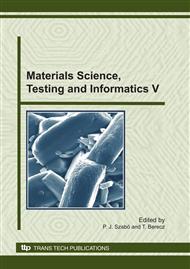p.109
p.115
p.121
p.127
p.135
p.141
p.147
p.153
p.159
Flame Retardant Polyethylene Terephthalate Fibers Added with Melamine Based FR Additive
Abstract:
Polyethylene terephtalate (PET) was modified with a melamine derivative additive in order to obtain flame resistance of fiber products. The effect of flame retardant (FR) agent was determined by measuring rheological and combustion properties of PET linear polyester. The solubility of additive was investigated using a torque-rheometer. In course of the rheological investigation, the rate of solution was determined. The effect of FR additive on the melt rheology could well be traced by using a torque-rheometer and its evaluation method. After preparation of polyethylene terephtalat and melamine mixture melt, fibers were made by coextrusion centrifugal apparatus. The flame retardancy of fibers were determined by standard combustion tests. These tests were performed in order to determine the oxygen index of fiber products. It was proven that a favourable degree of combustibility of PET can be obtained under the influece of adding melamine-derivative additive.
Info:
Periodical:
Pages:
135-140
Citation:
Online since:
September 2010
Authors:
Price:
Сopyright:
© 2010 Trans Tech Publications Ltd. All Rights Reserved
Share:
Citation:


